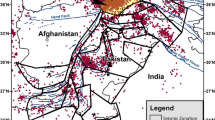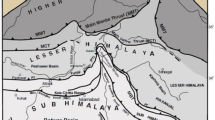Abstract
Earthquake is one of the devastating and frightening natural disasters that caused big casualties in a small duration. Earthquake caused lots of damage in just a few minutes and the casualties of the earthquake increase as the population increase which also contribute to higher amount of property and buildings. Therefore, by developing model capable of detecting the recurrence behaviour of earthquake helps in predicting earthquake as well as minimizing the casualties caused by the earthquake. In this report, a few of artificial intelligence algorithms such as support vector machine, boosted decision tree regression, random forest and multivariate adaptive regression spline will be used in the development of best model algorithm in earthquake prediction. Meteorological data are collected from several stations in Terengganu and processed for normalization and the data will be analysed using algorithms and its performance will be evaluated. Terengganu is situated on the east coast of Peninsular Malaysia and is bordered on the north-west and south-west by Kelantan and Pahang. Terengganu's east side is bordered by the South China Sea. Terengganu is located within the vicinity of the South China Sea, which is possible to be affected by the Marina Trench Earthquake. The subduction zone of Manila Trench is capable of producing a high magnitude of earthquake activity that can create a deadliest tsunami disaster. Therefore, Terengganu is studied for the investigation of artificial intelligence in earthquake prediction. The model algorithms are then analysed to measure its sensitivity and accuracy in prediction and consistency of the result.










Similar content being viewed by others
References
Abraham A, Steinberg D, Philip NS (2001) Rainfall forecasting using soft computing models and multivariate adaptive regression splines. IEEE SMC Trans Spec Issue Fusion Soft Comput Hard Comput Ind Appl 1:1–6
Asim KM, Idris A, Iqbal T, Martínez-Álvarez F (2018) Earthquake prediction model using support vector regressor and hybrid neural networks. PLOS ONE. https://doi.org/10.1371/journal.pone.0199004
Azamathulla HM, Deo MC, Deolalikar PB (2008) Alternative neural networks to estimate the scour below spillways. Adv Eng Softw 39(8):689–698. https://doi.org/10.1016/j.advengsoft.2007.07.004
Aziz AF, Mardi NH, Malek MA, Tan WK, Teh SY (2018) Determination of the most significant fault parameters for manila trench earthquake tsunami. IJET 7:248–253
Breiman L, Friedman JH, Olshen RA, Stone CJ, Breiman L, Friedman JH, Stone CJ (2018) Regression trees. In: Breiman L, Friedman JH, Olshen RA, Stone CJ (eds) Classification and regression trees. Routledge, pp 216–265
Boser BE, Guyon IM, Vapnik VN (1992) A training algorithm for optimal margin classifiers. In: Haussler D (ed) COLT ’92: Proceedings of the fifth annual workshop on computational learning theory, ACM, New York, pp 144–152
Coadou Y (2013) Boosted decision trees and applications. EPJ Web Conf. https://doi.org/10.1051/epjconf/20135502004
Deo RC, Samui P, Kim D (2016) Estimation of monthly evaporative loss using relevance vector machine, extreme learning machine and multivariate adaptive regression spline models. Stoch Env Res Risk Assess 30(6):1769–1784. https://doi.org/10.1007/s00477-015-1153-y
Elith J, Leathwick JR, Hastie T (2008) A working guide to boosted regression trees. J Anim Ecol 77:802–813. https://doi.org/10.1111/j.1365-2656.2008.01390.x
Everingham YL, & Sexton J (2011) An introduction to multivariate adaptive regression splines for the cane industry. In: 33rd ASSCT 2011, (December 2015) pp. 255–268
Ghasemi JB, Tavakoli H (2013) Application of random forest regression to spectral multivariate calibration. Anal Methods 5(7):1863–1871. https://doi.org/10.1039/c3ay26338j
Grant RA, Raulin JP, Freund FT (2015) Changes in animal activity prior to a major (M = 7) earthquake in the peruvian andes. Phys Chem Earth, Parts A/B/C. https://doi.org/10.1016/j.pce.2015.02.012
Guo L, Meng Z, Sun Y, Wang L (2016) Parameter identification and sensitivity analysis of solar cell models with cat swarm optimization algorithm. Energy Convers Manag 108:520–528. https://doi.org/10.1016/j.enconman.2015.11.041
Ismail S, Shabri A (2010) River flow forecasting: a hybrid model of self organizing maps and least square support vector machine. Hydrol Earth Syst Sci Discuss 7(5):8179–8212. https://doi.org/10.5194/hessd-7-8179-2010
Ismail S, Shabri A (2014) Stream flow forecasting using principal component analysis and least square support vector machine. J Appl Sci Agric 9(11):170–180
Jilani Z, Mehmood T, Alam A, Awais M, Iqbal T (2017) Monitoring and descriptive analysis of radon in relation to seismic activity of Northern Pakistan. J Environ Radioact 172:43–51. https://doi.org/10.1016/j.jenvrad.2017.03.010
Jumin E, Zaini N, Ahmed AN, Abdullah S, Ismail M, Sherif M, El-Shafie A (2020) Machine learning versus linear regression modelling approach for accurate ozone concentrations prediction. Eng Appl Comput Fluid Mech 14(1):713–725. https://doi.org/10.1080/19942060.2020.1758792
Keilis-Borok V (2002) Earthquake prediction: state-of-the-Art and emerging possibilities. Annu Rev Earth Planet Sci 30(1):1–33. https://doi.org/10.1146/annurev.earth.30.100301.083856
Keilis-Borok VI, Kossobokov VG (1990) Premonitory activation of earthquake flow: algorithm M8. Phys Earth Planet Inter 61(1–2):73–83. https://doi.org/10.1016/0031-9201(90)90096-G
Li W, Guo J, Yue J, Yang Y, Li Z, Lu D (2016) Contrastive research of ionospheric precursor anomalies between Calbuco volcanic eruption on April 23 and Nepal earthquake on April 25, 2015. Adv Space Res 57(10):2141–2153. https://doi.org/10.1016/j.asr.2016.02.014
Mohammadi M, Farzin S, Mousavi SF, Karami H (2019) Investigation of a new hybrid optimization algorithm performance in the optimal operation of multi-reservoir benchmark systems. Water Resour Manag. https://doi.org/10.1007/s11269-019-02393-7
Najah A, El-Shafie A, Karim OA, El-Shafie AH (2013) Application of artificial neural networks for water quality prediction. Neural Comput Applic 22:187–201
NanjoHollidayChenRundleTurcotte KZJRCCJBDL (2006) Application of a modified pattern informatics method to forecasting the locations of future large earthquakes in the central Japan. Tectonophysics 424(3–4):351–366. https://doi.org/10.1016/j.tecto.2006.03.043
Noori R, Hoshyaripour G, Ashrafi K, Araabi BN (2010) Uncertainty analysis of developed ANN and ANFIS models in prediction of carbon monoxide daily concentration. Atmos Environ 44(4):476–482. https://doi.org/10.1016/j.atmosenv.2009.11.005
Peresan A, Kossobokov V, Romashkova L, Panza GF (2005) Intermediate-term middle-range earthquake predictions in Italy: a review. Earth-Sci Rev. https://doi.org/10.1016/j.earscirev.2004.07.005
Rong LX, & Bar-Shalom Y (1992). Performance prediction of the interacting multiple model algorithm. In: Proc American Control Conf 3: 2109–2113
Saad P, Shabri A, Samsudin R, Saad P, Shabri A (2010) A hybrid least squares support vector machines and GMDH approach for river flow forecasting. Hydrol Earth Syst Sci Discuss 7:3691–3731. https://doi.org/10.5194/hessd-7-3691-2010
Taylor KE (2001) Summarizing multiple aspects of model performance in a single diagram. J Geophys Res Atmos 106(D7):7183–7192. https://doi.org/10.1029/2000JD900719
Toya Y, Tiampo KF, Rundle JB, Chen CC, Li HC, Klein W (2010) Pattern Informatics approach to earthquake forecasting in 3D. Concurr Comput Pract Exp 22(12):1569–1592. https://doi.org/10.1002/cpe.1531
Willmott CJ, Ackleson SG, Davis RE, Feddema JJ, Klink KM, Legates DR, Rowe CM (1985) Statistics for the evaluation and comparison of models. J Geophys Res 90(C5):8995. https://doi.org/10.1029/jc090ic05p08995
Acknowledgements
This study financially supported by the Grant 2020105TELCO received from the Innovation & Research Management Center (iRMC), Universiti Tenaga Nasional (UNITEN) in Malaysia and Telkom University, Bandung in Indonesia.
Author information
Authors and Affiliations
Corresponding author
Ethics declarations
Conflict of interest
The author(s) stated no possible conflict of interest.
Additional information
Publisher's Note
Springer Nature remains neutral with regard to jurisdictional claims in published maps and institutional affiliations.
Rights and permissions
About this article
Cite this article
Marhain, S., Ahmed, A.N., Murti, M.A. et al. Investigating the application of artificial intelligence for earthquake prediction in Terengganu. Nat Hazards 108, 977–999 (2021). https://doi.org/10.1007/s11069-021-04716-7
Received:
Accepted:
Published:
Issue Date:
DOI: https://doi.org/10.1007/s11069-021-04716-7




